Tour of Santo Antao Island

Ile Jeudi
Bob and Lin Griffiths
Thu 7 Feb 2013 21:13
|
Thursday 7 February 2013
We took a ferry to the neighbouring island of Santo
Antao. The journey is about an hour and the ship is rather dilapidated and
we understand only one of it's two engines is working. It was
disconcerting when one of the crew started handing out sick bags to all the
passengers soon after we left Mindelo. A few of these were used as even
though it was not rough we were rolling as the waves came beam on.
Santo Antao is the most north westerley of the
island group and has the most vegetation. Most of the fruit and vegetables
eaten in the Cape Verde islands are grown here apparently.
We had seen a recommendation to use a Belgian guide
called Pascal if possible but we had no idea how to find him amongst all the
drivers touting for business. Jackie from a neighbouring boat on our
pontoon came to find us to say that there was space in the pick up truck they
were using so we joined her. We then discovered the driver was
Pascal! He was very good, had excellent English and was very enthusiastic
about the island. We would also recommend him.
We drove first to high points in the centre of the
island where it was greener. The cobbled road was built by 2500 slaves and
prisoners (Portugal used to chuck their prisoners out here) over many
years. The mountain tops were dramatic in that there were very steep drops
to deep, green valleys in the interior. Very much like the centre of
Madeira but perhaps steeper and not as green.
It's a long way down to those remote
houses:-
 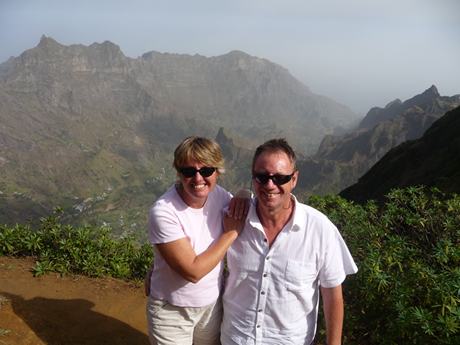 Three of the passengers, including our neighbour
Jackie, were dropped off so they could walk down to the bottom of the valley
leaving us and another couple. Celine is English and her husband is Dutch
but has lived in the UK for many years. They were on a weeks holiday and
chose Cape Verde partly because it was 'near the equator', ie warm and sunny, to
escape the UK winter for a while although it became clear they are
more adventurous with their destinations than many. These are
the first Brits we have come across other than those off cruise ships
or on boats.
We were taken to the north of the island to a small
fishing village, Porto da Ponta do Sol.
The small fishing boats are manhandled
ashore:-
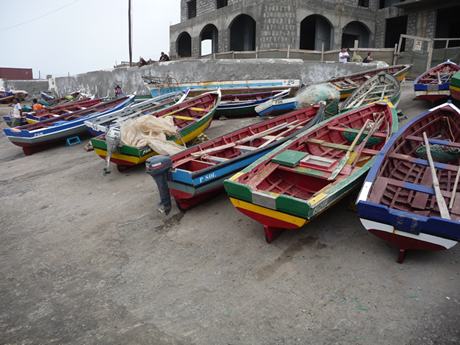  Looking across the small harbour to the
village:-
 The catch being weighed on balance
scales. No Weights and Measures people here:-
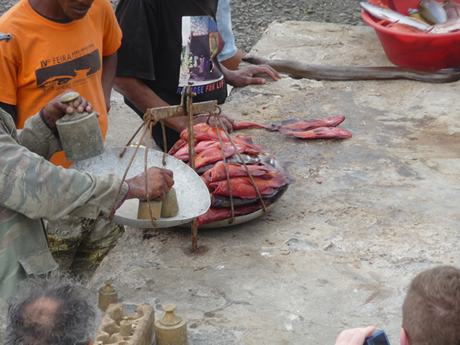 Next stop was Ribeira Grande where we had lunch in
a place we would never have found on our own - the entrance door seeming
anonymous and leading into a small open area surrounded by buildings.
Sheltered from the wind and somewhat like a back yard but full of character with
nice simple food from a clean kitchen (someone I know checked at
this). We all had the dish of the day
- some 'hacked chicken' in a stew served on rice.
The chef at another table looking very
proud:-
 Pascal took us into the valleys in the centre of
the island. Sugar cane growing here:-
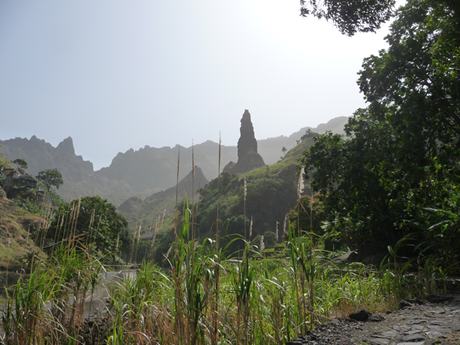 and here, together with breadfruit, mangoes,
bananas and yams. Just like the Caribbean:-
 Then on to a small 'grog' distillery. The rum
is made from sugar cane and sometimes mixed with natural fruit juices which of
course we sampled. This one crushes the cane in 'the old fashioned way',
the press being driven by cattle tethered to these long arms and walking in
circles:-
 A few wildfowl around the place. Lin is
looking at an old photograph of the distillery in action with Rick and
Celene:-
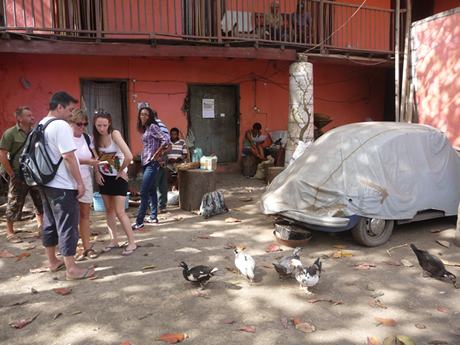 Pascal took us back just in time for the ferry
which left slightly before the scheduled 5pm departure time and we were back in
Mindelo by 6pm.
|